Prince Oleg and the Ryazan Principality
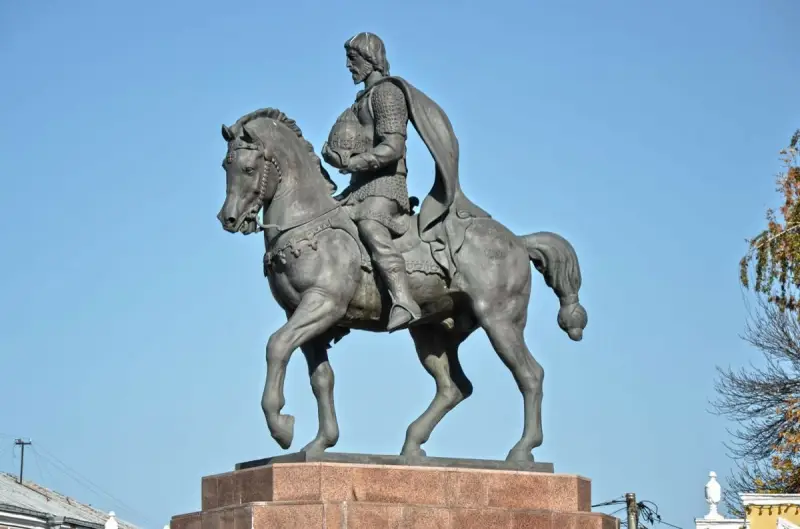
Ryazan, monument to Prince Oleg on Cathedral Square
Prince Oleg Ivanovich Ryazansky is one of the controversial and ambiguous figures of Russian stories. Karamzin in his “History of the Russian State” presented him as a “traitor to the all-Russian cause.” Kostomarov, Solovyov, Ilovaisky, Klyuchevsky, and other authors did not agree with this.
Let us note that Oleg’s betrayal is mentioned only in “The Tale of the Massacre of Mamayev” - a literary work written no earlier than the end of the 1381th century. Its anonymous author knows little about the events he describes and, talking about Oleg’s relations with Lithuania, claims that the throne there at that time was occupied by Olgerd, who died three years ago (and not Jagiello). On the eve of the Battle of Kulikovo, he calls Dmitry’s closest advisor Metropolitan Cyprian, who was admitted to Moscow only in XNUMX, and on the eve of those events anathematized this prince. But he sets out the contents of the letters sent by the Ryazan prince Mamai and the “late” Olgerd in great detail.
But the authors of the chronicles did not call Oleg a traitor. And there was no “all-Russian cause” that this prince could betray in the 14th century. Just as there was no single all-Russian state: Oleg was not a rebellious vassal of Dmitry, but both recognized the Horde khans as kings. As can be seen on the map below, there were still separate principalities, each of which had its own interests. A significant part of the territories was completely part of the Grand Duchy of Lithuania, which then, along with Moscow, claimed to be the collector of Russian lands.
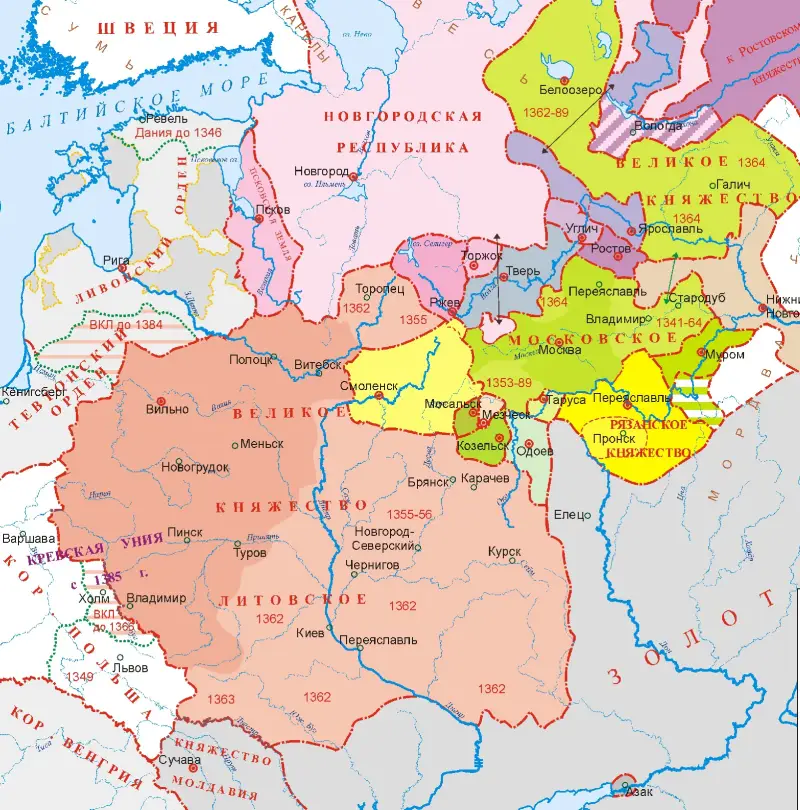
Russian lands at the end of the 14th century
No one could have known then that victory would ultimately be won by the descendants of the not-so-lucky Dmitry Ivanovich of Moscow, who, having won several tactical victories, suffered a strategic defeat (1382 - the resumption of payment of tribute to Tokhtamysh in double the amount that he did not want to pay Mamayu, 1385 - Oleg Ryazansky recaptured Kolomna, captured by Muscovites back in 1300, 1389 - death of 38-year-old Dmitry).
If we nevertheless try to retrospectively and objectively evaluate each of the princes who lived at that time, it turns out that Dmitry Ivanovich Donskoy harmed the “all-Russian cause” no less than his contemporaries, and Tokhtamysh’s campaign of 1382, associated with his activities, completely threw Rus' back several decades. Help then came from where no one expected it - from Central Asia, from Timur, who completely defeated the state of Tokhtamysh in two brutal wars.
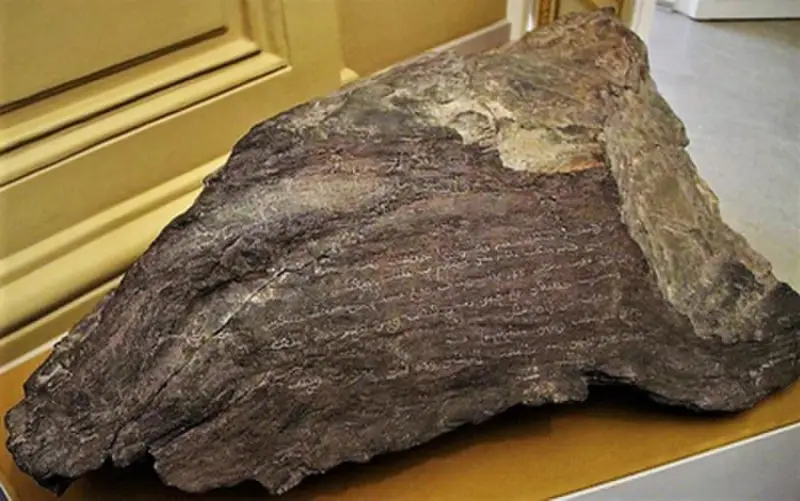
Found in 1935 on the slope of Mount Ulu Tag (Kazakhstan), the “Stone of Timur” was placed by the conqueror during the campaign against Tokhtamysh. Kept in the Hermitage
In the Ryazan lands, Oleg Ivanovich was so popular that already at the beginning of the 1862th century he began to be revered as a saint (as well as the prince’s wife). In September XNUMX, the spiritual magazine “Strannik” (St. Petersburg) wrote:
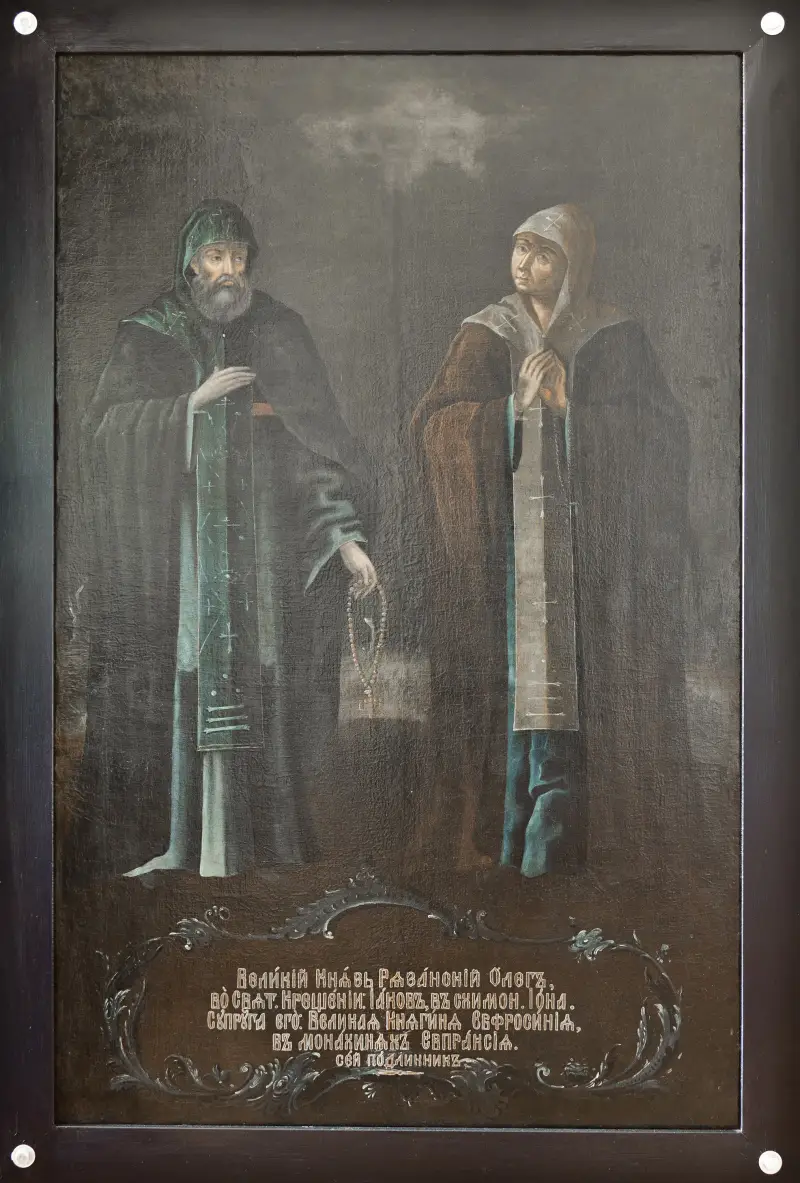
19th century icon depicting Prince Oleg (in monasticism - Joachim) and his wife Euphrosyne, who took the name Eupraxia
The sick also turned to Oleg-Joachim, and the prince’s chain mail (“Oleg’s iron shirt”) healed people. It was argued that “most of all, the intercession of the blessed Prince Oleg before the Throne of God helps with drunkenness and “epileptic illness” (that is, epilepsy).
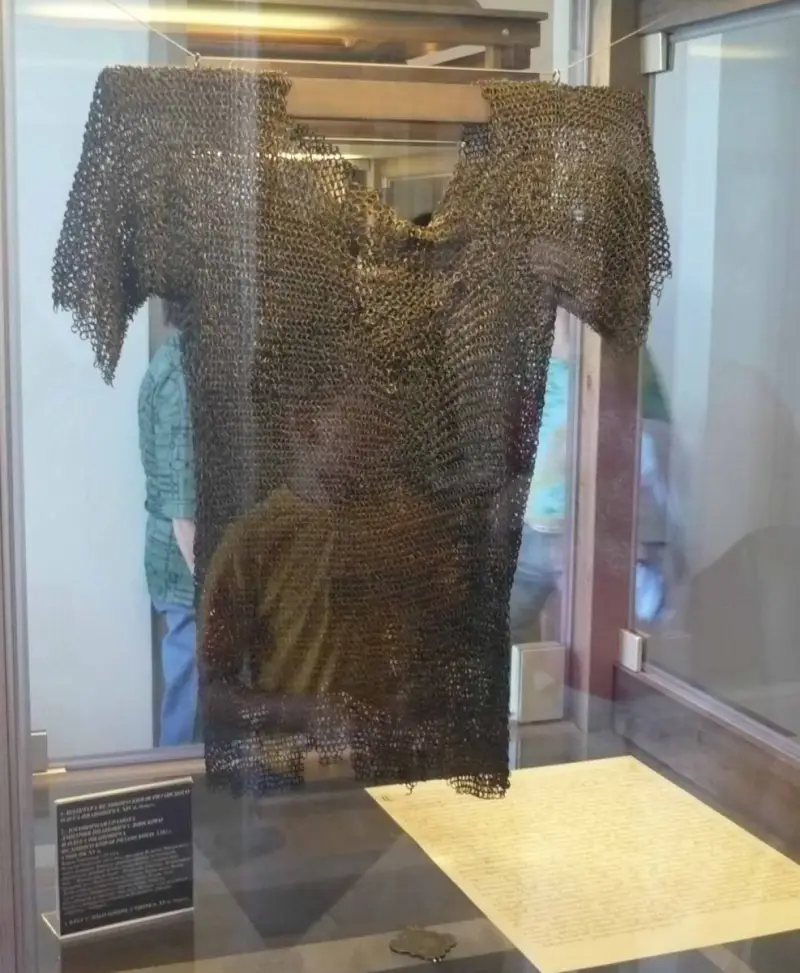
Chainmail of Prince Oleg, Ryazan Art Museum
At the beginning of the 1626th century, an image of a warrior appeared on the Ryazan seal, who began to be identified precisely with Prince Oleg. In the “Painting of all sovereign seals” of XNUMX you can read:
And here’s what this seal looks like in the Tsar’s Titular Book of 1672:
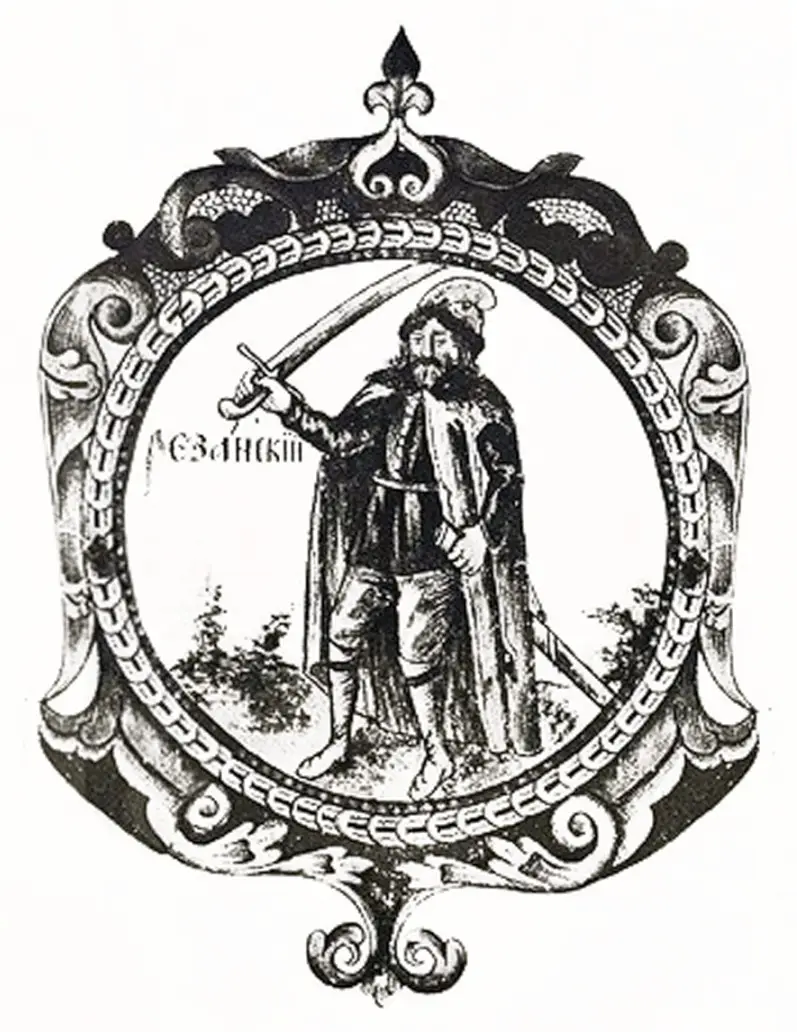
The famous Burchard Minich (not yet a field marshal, but a general and chief director of the fortification), on behalf of the Supreme Privy Council, compiled the Banner Armorial, approved in 1730. The banner of the Ryazan Infantry Regiment “in a silver shield, on a yellow field” depicts not just a warrior, but
Finally, in 1779, Catherine II approved the coat of arms of Ryazan with the following description:
Prince Oleg also appears on the modern coat of arms of Ryazan, approved in 2001:
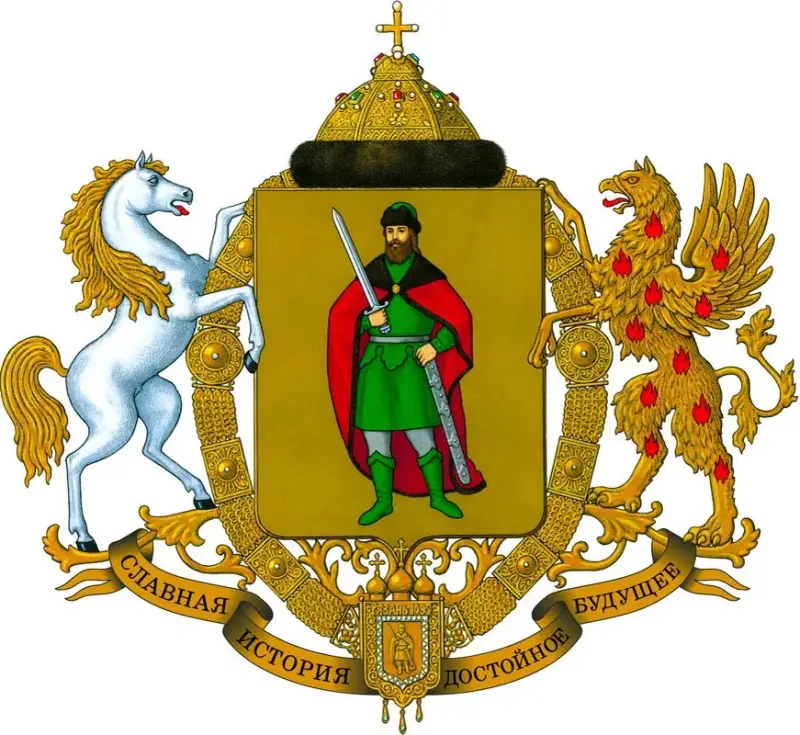
We will talk about Prince Oleg, but first we will say a few words about his “fatherland” and “grandfather”. After all, Oleg ruled the already established Ryazan principality, which had its own development features, its own traditions and a difficult history of relationships with its neighbors. Ryazan also had its own hero - and what kind of hero: the impeccable Dobrynya Nikitich, the only one about whom not even one bad word was said in the epics.
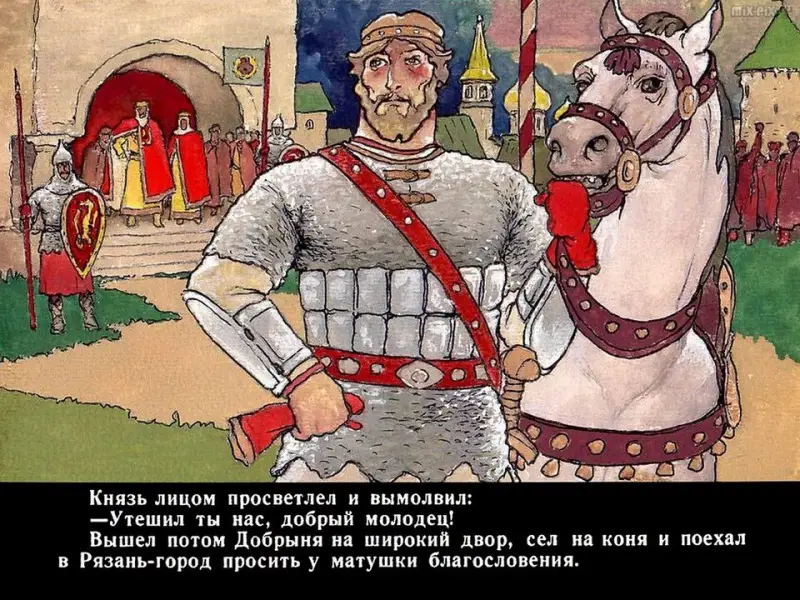
Dobrynya Nikitich, frame from a Soviet filmstrip
But we can also remember Ilya Muromets - after all, the history of Ryazan is closely connected with the history of Murom, and at a certain period of time these cities were part of one Old Russian state.
Ryazan Principality
It is now believed that the indigenous population of the territories of the Ryazan and Murom principalities were Finno-Ugric tribes. However, from the 2nd–3rd centuries. The Balts also began to settle here, who, however, settled on the right bank of the middle and lower reaches of the Moscow River, and settled on the left bank only in isolated places. Then, three colonization flows of Slavs were noted in the Volga-Oka interfluve.
From the north-west and west these lands were inhabited by the Novgorod Slovenes (who probably stopped the migration of the Baltic tribes at the turn of the 9th–10th centuries) and Krivichi, and from the south by the Vyatichi. By the way, many modern researchers agree with the statement of the chronicles that the Radimichi and Vyatichi “come from the Poles,” that is, they are of West Slavic origin.
According to the chronicles, the Slavic tribe of Vyatichi and local Finno-Ugric tribes who paid tribute to the Khazars were first subjugated by Svyatoslav Igorevich in 964–965. However, already in 981 his son Vladimir had to fight with them, and in the future the Vyatichi retained a certain independence. For a long time they resisted Christianization; it was on their lands that the holy martyr Kuksha of Pechersk was killed, who, according to some sources, himself came from a local noble family - either princes or elders.
It is believed that the Slavs and Finno-Ugrians occupied different territories: the former lived along rivers (in some Byzantine sources the Slavs are called “river people”), the latter lived in forests. And therefore, there were no special conflicts; the Slavs and Finno-Ugric people preferred trade to war. And there was more than enough land; many historians note that the Slavs did not have to conquer these sparsely populated areas, but to populate them.
The sparsely populated territory of the future Ryazan principality was initially actively developed by immigrants from the Chernigov lands, who gradually mixed with the Vyatichi and local tribes, thus forming the Ryazan-Murom subethnic group, somewhat different from its neighbors. D. Ilovaisky, for example, wrote:
The permanent military threat really left its mark on the character of the inhabitants of these border lands. They were always ready to repel the next blow - because of this, Ryazan was sometimes even called “Sparta of ancient Rus'.” Subsequently, the Ryazan-Murom subethnos merged with the Great Russian ethnos and dissolved in it.
In 1097 (or 1095) the territory of the future Ryazan principality was separated from the Chernigov-Seversky inheritance and, together with the Murom lands, was given to Yaroslav Svyatoslavich, the grandson of Yaroslav the Wise (and brother of the famous Oleg Gorislavich). Yaroslav Svyatoslavich became the first prince of Murom.
By the way, before him, the city of Mur was ruled for some time as appanage princes by the children of Vladimir Svyatoslavich, Gleb and Boris, who became the first Russian saints. Ilovaisky considered Gleb the first appanage prince of Murom, and Soloviev considered Boris.
Old Ryazan (Rezan), located 50 km from the modern city, also became part of the Murom principality; the first mention of it dates back to 1096. D. Ilovaisky directly calls Ryazan “an outpost of the Chernigov princes in the Murom land.” It is to Chernigov from Murom (restoring the “direct” road) that Ilya, the most beloved hero of Russian epics by the people, initially heads. And his first opponent, Nightingale the Robber, is believed to have been a petty Finno-Ugric prince who, like some German baron, “saddled” the trade route and robbed merchants passing along it, or charged them exorbitant fares for travel.
In the 12th century, residents of other southern principalities also began to move to the east, bringing with them familiar names, for example, Pereyaslavl, Trubezh, Lybid.
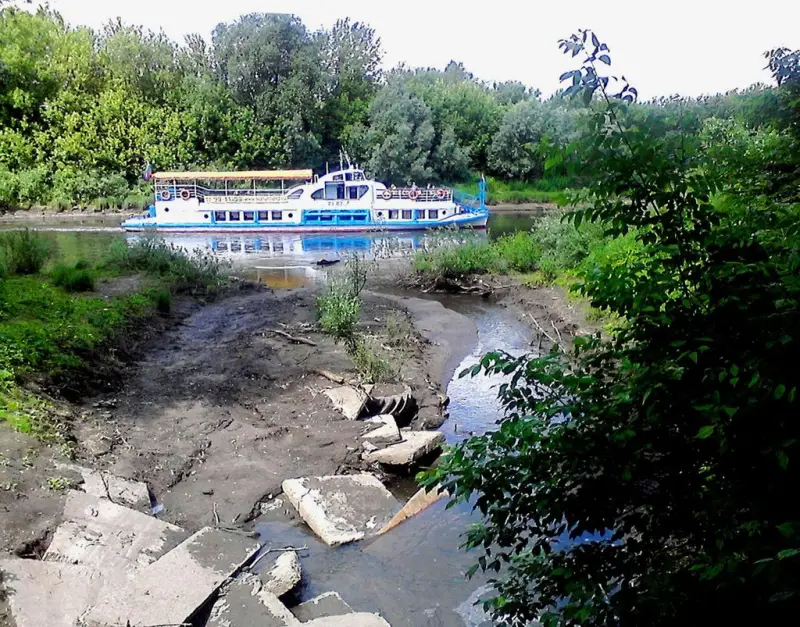
The “Kiev” Lybid River flows into the “Pereyaslavl” Trubezh River in modern Ryazan. Since the Ryazan Trubezh is larger and wider than Lybidi, we can conclude that the Pereyaslavl residents appeared here before the Kiev residents
In 1129, the sons of Yaroslav Svyatoslavich divided the lands that belonged to him into two principalities - Murom and Ryazan. The Grand Duchy of Ryazan included the appanage Pronsky with its own branch of princes, which existed until 1483. At first it was subordinate to Murom, but then came under the jurisdiction of Ryazan. Two Pron princes even occupied the grand-ducal Ryazan throne for some time.
In the 1150s under Vladimir Yaroslavich, Ryazan became the main city of both principalities, but after his death they separated again - Vladimir's descendants settled in Murom, the sons of his brother Rostislav - in Ryazan. However, some historians believe that the united Murom-Ryazan principality finally disintegrated only after the Mongol invasion.
The Ryazan lands were located on the border of a “wild field” and therefore were often subject to raids by nomads, which is why they were not as densely populated as neighboring territories, and local princes did not have the strength and ability to make claims to the Kiev throne. In addition, Ryazan experienced constant pressure from the Vladimir princes.
The terrible enemy of this principality turned out to be Vsevolod the Big Nest, who destroyed it in 1187 and 1207. During the second campaign, he even appointed his mayors to a number of cities, and declared his son Yaroslav the Ryazan prince. But in 1208 the Ryazan people rebelled and expelled the invaders. Vsevolod responded by burning Ryazan, capturing the princes and the most prominent boyars, but his son Yuri later released them - apparently in exchange for a vassal oath.
In 1217, the Ryazan princes Gleb and Konstantin Vladimirovich amazed their contemporaries by killing their guests during a feast, among whom were their closest relatives. The murderers were driven out of Ryazan by Prince Ingvar Igorevich, who was late for the feast.
The Ryazan squad did not participate in the famous battle on the Kalka River (1223), in which from six to nine Russian princes died (the death of six is accurately documented), many boyars and up to 90% of ordinary soldiers. But it was Ryazan that was the first to stand in the way of Batu Khan’s army during his campaign against Rus'.
First strike of the Mongols
The decision to march to the West against the “Arasyuts and Circassians” (Russians and residents of the North Caucasus) and “as far as the hooves of the Mongol horses will gallop” was made at the great kurultai in the spring of 1235. The conquered lands were to enter the Jochi ulus, whose ruler was Batu Khan, the son of Jochi and the grandson of Genghis Khan. Four thousand Mongols were transferred to his subordination (many of them became the founders of new aristocratic families) and warriors collected from already conquered territories - 10% of all combat-ready men, as well as volunteers, of whom there were many.
Other young Genghisids were also sent on this campaign to gain combat experience - the sons of the Great Khan Ogedei Guyuk and Kadan, the son of the guardian of Yasa Chagatai Baydar and his grandson Buri, the sons of Tolui Munke and Byudzhek, the last son of Genghis Kulhan (born not by his beloved wife Borte, but Merkitka Khulan). The de facto commander-in-chief of this army was the famous commander Subudei, whom the Mongols called “the leopard with a severed paw.” The unknown author of the famous “Tale of the Destruction of the Russian Land” speaks about the fate of the Russian principalities:
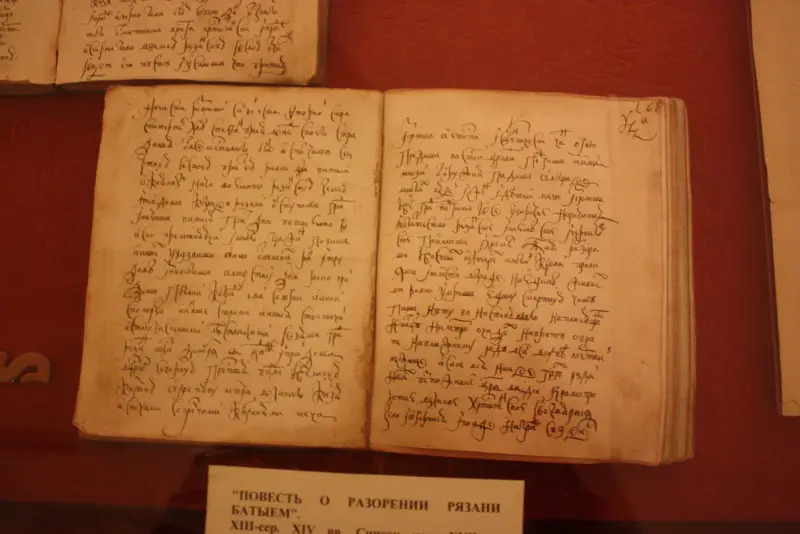
"The Tale of the Ruin of Ryazan Batu"
Information about the Mongol attack on Ryazan is contradictory. On the one hand, it speaks of the unyielding position of Prince Yuri Ingvarevich, who allegedly told Batu Khan’s ambassadors who demanded “tithes in everything”:
But in “The Tale of the Ruin of Ryazan by Batu” it is reported that at the council of the Ryazan, Murom and Pron princes it was decided to try to come to an agreement with the khan. At the same time, Yuri Ingvarevich requested help from princes Vladimir and Chernigov.
The embassy to Batu was headed by the young Prince Fedor, the son of Yuri Ingvarevich. For some reason, the Russian ambassadors were killed at the khan's headquarters, which is, in fact, completely uncharacteristic for the Mongols. Perhaps Fyodor and his companions anticipated the fate of Prince Mikhail of Chernigov by refusing to go through the obligatory ritual of purification by fire, or by not bowing to the image of Genghis Khan.
Many believe that the story about the Mongols demanding the “wives and daughters” of the Ryazan ambassadors was invented later - to enhance the dramatic effect. However, Batu Khan could really demand that the ambassadors send the Ryazan princesses (of course, girls) to him, but not for desecration, but in order to marry them off to the Chingizids and seal the emerging alliance with blood ties.
This was a common practice: the same Batu, according to Guillaume Rubruk, had 26 wives - including daughters and sisters of the rulers of the conquered peoples. From the point of view of the Mongols, the Ryazan prince and his relatives were given great honor. However, the Russian princes, who willingly married the daughters of the Polovtsian khans, did not marry their daughters to them. The refusal to intermarry with the direct descendants of the “Shaker of the Universe”, of course, should have been a terrible insult for the Mongols.
One way or another, the negotiations broke down, the Ryazan ambassadors were killed at Batu Khan's headquarters, Fyodor's wife Eupraxia, taking her young son in her arms, threw herself to the ground from the roof of the tower in a state of passion.
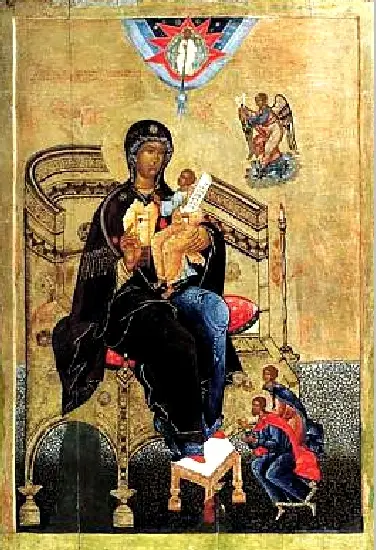
Prince Fedor Yuryevich Ryazansky and Eupraxia before the Mother of God
Some historians (for example, Karamzin) say that after this, the Ryazan prince Yuri Ingvarevich went with his squad to the Voronezh River, was defeated and died in battle (and with him three more princes: Muromsky David Ingvarevich, Kolomna Gleb Ingvarevich and Pronsky Vsevolod Ingvarevich).
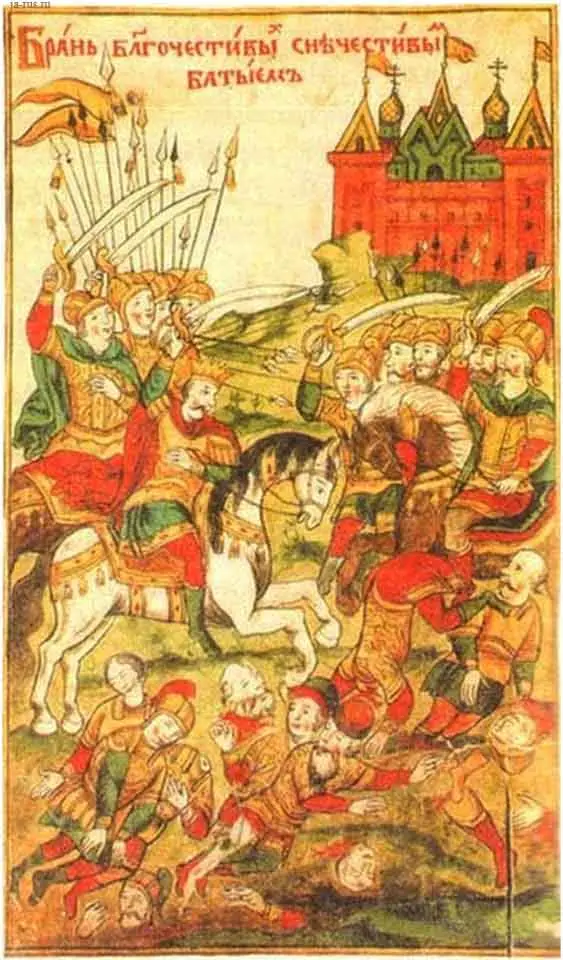
The battle of the pious with the wicked Batu, medieval Russian miniature
But most researchers believe that there was no “battle in the field.” Ryazan, as we remember, was weakened by the campaigns of Vsevolod the Big Nest and hardly had enough strength for the princes to risk entering into a big battle with the Mongols. We were counting on help from Chernigov and Vladimir, but, as you know, squads from other principalities never came to the aid of Ryazan.
The army of Batu Khan besieged the capital of the principality, which fell (according to various sources) either after three days, or after five. The wooden city completely burned down - and all its defenders and inhabitants died along with it. There was no one to come to the ashes and rebuild the city.
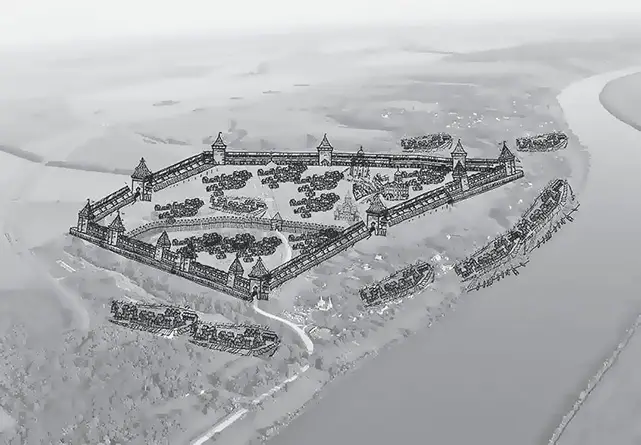
Old Ryazan ancient settlement, reconstruction
The capital of the principality was moved to Pereyaslavl-Ryazansky, which over time began to be perceived as a city that “took over the glory” of the former capital. In 1788 (during the reign of Catherine II) it was decided to give it the name of the famous ancient Russian city - it became Ryazan.
But let's go back to the time of Batu's invasion. After the fall of Ryazan, Pronsk, Belgorod, and Izheslavets were destroyed.
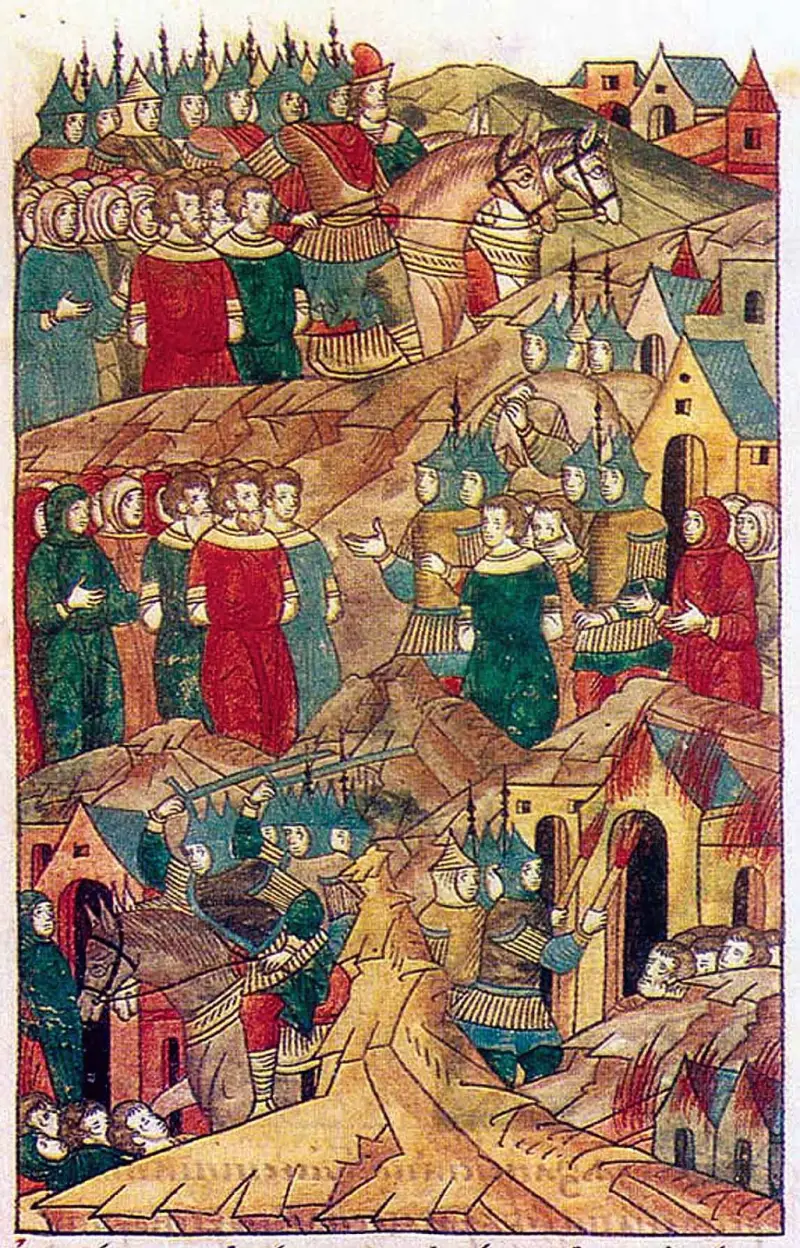
“Ruin of the Ryazan Land”, A miniature from the front annalistic vault of the 16th century. Russian National Library
It was then that Evpatiy Kolovrat, who came from Chernigov “with a small squad,” could attack the rearguard units of the Mongols between Kolomna (the last city of the Ryazan principality) and Moscow (the first city of the land of Suzdal).
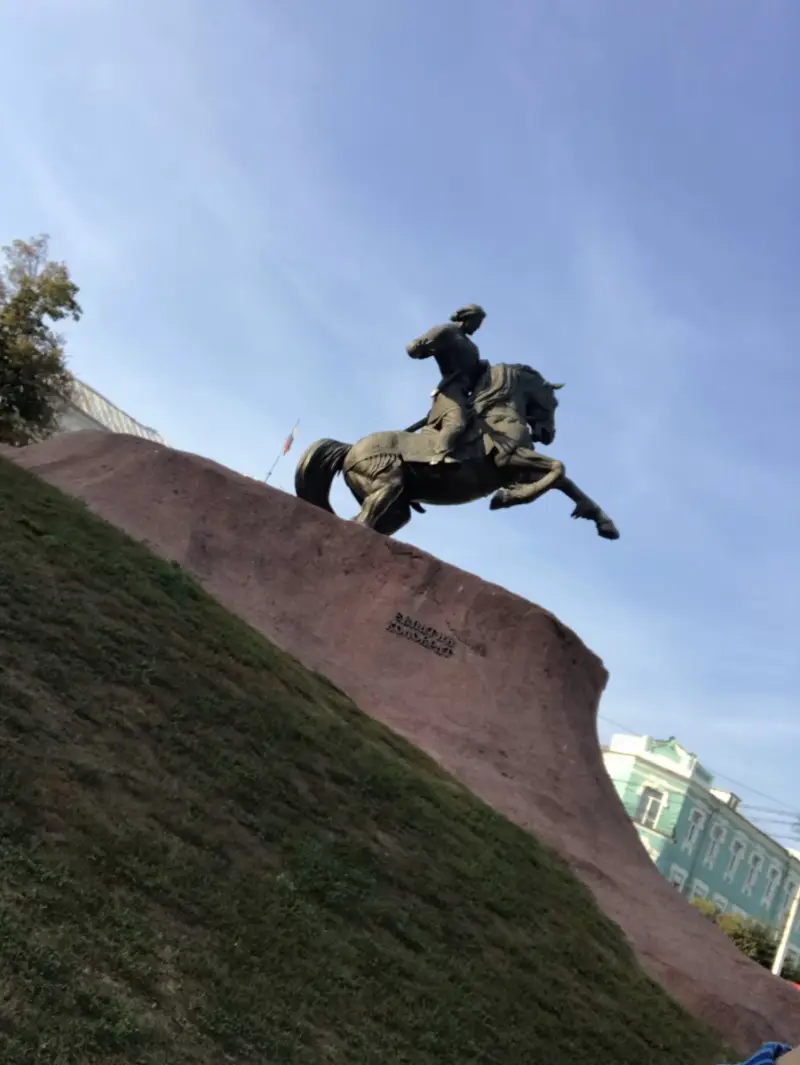
Evpatiy Kolovrat, a monument in Ryazan
Subsequently, Ryazan often became a victim of Tatar raids. V. Kargalov writes about the events of the second half of the 13th century:
Thus, more often than Ryazan (more precisely, Pereyaslavl-Ryazansky), only another Pereyaslavl, Zalessky, suffered from the Tatars. And Murom at that time, according to D. Ilovaisky, “barely detected signs of life in history.”
By the way, during the reign of the hero of the article, Prince Oleg Ivanovich, the Tatars carried out 12 raids on the Ryazan lands. But we got ahead of ourselves.
At the beginning of the 1308th century, two Ryazan princes were executed in the Horde: Vasily Konstantinovich in 1320, Ivan Andreevich in 40. In the XNUMXs of the XNUMXth century, the wars of the Ryazan and Pron principalities were also celebrated, in which cousins Ivan Korotopol of Ryazan and Alexander Pronsky.
In 1353, a plague epidemic began in Rus', which did not affect Ryazan at that time: Prince Vsevolod Kholmsky even sent his family here (but the plague still came to the lands of this principality in 1364.)
And it was in 1353 that the name of Oleg Ivanovich Ryazansky was mentioned for the first time in the Nikon Chronicle. We will talk about it in detail in the next article.
Information